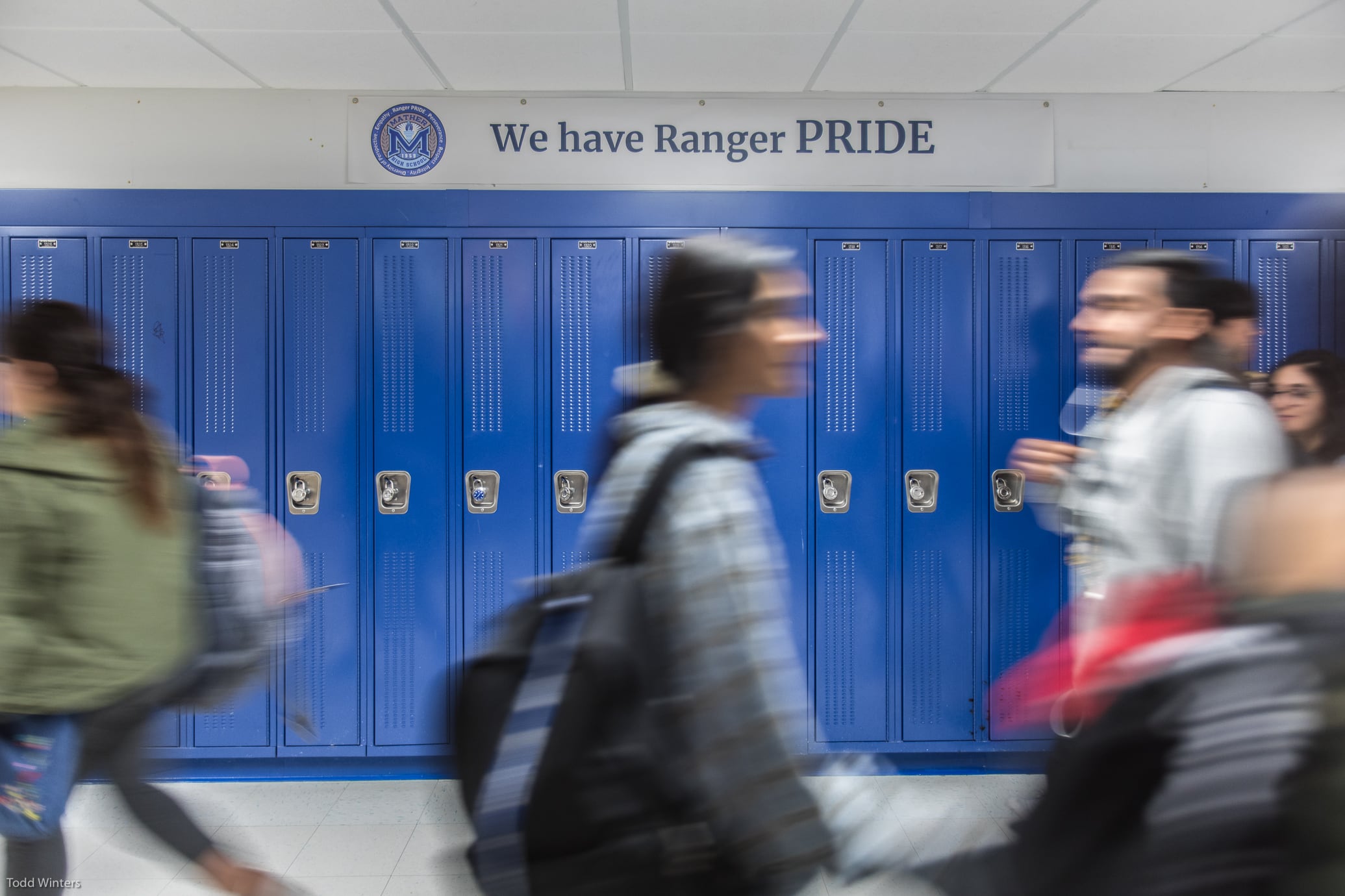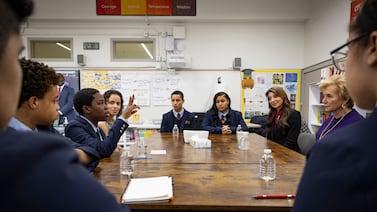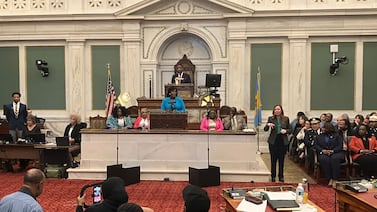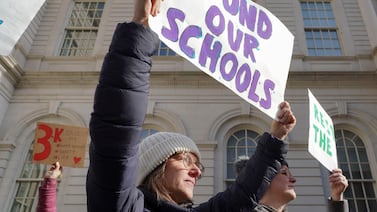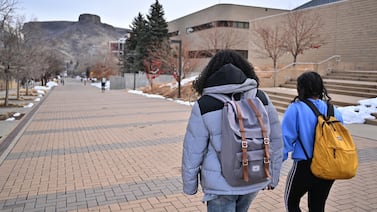On a normal school day, the seventh-grader would have bounded into Nadia Jelinek’s counselor room and given a staff member at Maria Saucedo Scholastic Academy in Little Village a hug.
The student came from a family that didn’t have much contact with the school, and she was often left to figure out school work and other logistics on her own. But she found support from the social-emotional team at Saucedo. “She liked talking to us,” said Jelinek, a school counselor who worked with often hard-to-reach youth.
When schools closed for the coronavirus pandemic, that all fell apart. The student fell out of touch.
Chicago Public Schools started remote learning in earnest in April, nearly four weeks after students were first sent home. The district’s participation rates inched up higher and higher as remote learning progressed and spiked after it introduced a new grading policy in May. Some students logged on late — something schools still considered a success — but others never logged on at all. Efforts to reach the students who fell out of contact offer a blueprint and a warning for the months of hybrid or remote schooling to come.
In late May, the district released data that showed 2,332 students in Chicago across 251 schools were considered out of touch with their schools from the beginning of remote learning until May 28, just before the end of the school year. Two months later, district leaders released a revised set of numbers, saying just a fraction of the original number — 559 students — were counted as off the grid as of July 17. Chicago has a total of 293,712 students in district-run schools.
For the revised total, district leaders were more optimistic: They assumed students were in contact with their school if they picked up a device or received a letter grade at the year’s end, even if they were marked as out of touch all spring.
The two sets of data show just how hard it is to put a precise number on how many students missed out on remote learning this spring — a critical consideration as the district rolls out a hybrid plan for fall that relies on some distance learning — and how to best serve the social support role that many schools play in Chicago communities. The numbers also raise questions about who’s responsible for finding missing students: Is it teachers, schools, or the district office?
For some schools, the percentage of students who fell off the grid was tiny — Edward Everett Elementary School in McKinley Park had just one student who didn’t log on — while for others, a sizable group of students never logged on. The highest rate was 26%, or 177 students, at Foreman College and Career Academy in Belmont Cragin, according to the original data.
The schools that struggled most to contact all of their students were in Black and Latino communities hit disproportionately hard by COVID-19; they also were more likely to have a higher percentage of Black students and students who receive subsidized lunch. Of the 23 schools that were unable to contact 5% or more of their students, more than half were elementary schools.
“This is an unprecedented crisis in which all the structural and social failures of schools and society have been unmasked,” said Pauline Lipman, a long-time education researcher and professor at the University of Illinois at Chicago. “This is a reflection of the deep racial and social inequalities in the city.”
In Chicago, with its decentralized approach to school management, the responsibility for finding these students largely fell on individual schools, which scrambled to find new methods of outreach and student tracking, even as they moved quickly to engage students in remote learning. Schools also were limited in their tracking efforts by strict rules about contact with students, the result of a 2018 investigation that revealed systemic failures to protect students from sexual abuse. The rules forbid teachers from reaching students on their personal cell phones or email accounts.
In a statement, district officials said they are concerned about any student who disengages from school and would continue encouraging schools’ outreach efforts. The district said it supported schools in those efforts by offering “contact escalation” guidelines and assisting in some contact requests.
But educators fear that with a fall of uncertainty looming, and the virus and subsequent economic fallout continuing to ravage Black and brown communities, students who pulled away from school in the spring will only fall further out of touch. That could lead to months of lost learning, a disconnect from the support of school communities, and students disengaging from school altogether.
Several weeks into remote learning, Jelinek, the counselor at Saucedo, had heard nothing from the usually friendly seventh-grade student, so she turned to the school’s newly created student contact system: keeping track of any outreach efforts in a spreadsheet, reaching out to the student’s friends, and engaging partners with Communities In Schools of Chicago, a nonprofit that deals with dropout prevention.
She finally reached her. The student told Jelinek that she hadn’t felt motivated to engage in online learning. But, with some help, “She was able to catch up, do her work, and ended up passing,” she said.
Other students fell off the grid and stayed off.
With no clear record of what happened to the students who stayed out of touch, even weeks into the summer, educators are left only with guesses: family illness, sudden relocations, taking on new responsibilities like caring for siblings, working to keep their family afloat or simply the mental distress caused by the rapid shutdown of schools.
Educators say that knowing what students need, even if it’s beyond the bounds of the schools to always provide it, could be the difference between months of lost learning and a school community that manages to push through the schooling disruption wrought by the virus.
Tracking students amidst a societal shakeup
Belmont Cragin was facing one of the biggest coronavirus outbreaks in the city this spring. At Foreman, a neighborhood high school in the area, 26% of students fell out of contact with the school after the campus closed. It was the highest rate of any school in Chicago.
Educators there say it wasn’t for lack of trying.
Jessica Cipicchio, a special education teacher at Foreman, said the school first tried student email, followed by phone calls to families, then letters dropped off at their homes.
What they found were students watching young cousins or siblings, in unstable housing situations, taking on new jobs or extended hours, or struggling to deal with family tragedy.
“Our administration did an amazing job of trying to contact every student to give them a Chromebook or WiFi, but a lot of our students are essential workers,” she said.
During normal school times, the school district tracks daily attendance, and it factors those numbers into school ratings. If a child doesn’t come to school, elementary school staff members are expected to call a parent or guardian. In high school, a student is marked as absent if they miss two or more classes a day, which also triggers a robo-call home.
During the pandemic, the district suspended this system, saying no students would be counted as truant or absent during this period. The district said it supported 400 requests from individual schools for assistance in contacting students, but it declined to share how successful those efforts were.
Schools led the effort to make contact with students, particularly in the first weeks of school shutdowns.
At Saucedo, the principal created an outreach team, led by Jelinek, which used a tracker form to focus on students who were hard to reach. Many of the students who dropped off the grid already had low engagement before the shutdown. The tracker helped the school get to a granular level of outreach — staff members wrote notes like “Mom is working right now but available at 10 a.m.” and “This student has not attended math class for weeks, but they logged in to a meeting with their counselor.”
In mid-May, Chicago Public Schools introduced a centralized student tracking metric into its Aspen grading and parent portal that required schools to track weekly contact data.
Some educators raised concerns that the new tracking metric was unreliable, as multiple teachers could change a student’s contact status. One teacher may have logged a contact with a student on a particular day but another teacher, missing the student in their class an hour later, would have logged them as unreachable.
For students who couldn’t be reached, the district suggested that schools confirm some minimal level of activity weekly — such as a phone call with a parent or a log-on to a learning platform, even if a student didn’t engage further — and track both successful and unsuccessful outreach. If a student couldn’t be reached by a teacher three different times on three different days, the teacher was supposed to alert their school support team and then take the case to the district support office.
In some cases, students may just be unreachable, the district said.
That left many teachers going it alone - and feeling unsupported in that work.
Lisset Rosales, a bilingual 3rd grade teacher at Grover Cleveland Elementary in Irving Park, created an Excel form to share with other teachers in her grade. It noted not only if a student was in touch but how often and by what means. She helped parents find resources for groceries, and also held parent training about remote learning.
“CPS had their own system where we had to do a weekly check-in, but I felt it was not as successful because there was not enough data,” said Rosales.
Rosales used her spreadsheet to come up with a best way of contact for each child. Maybe it was through a parent’s cell phone or an app called Class Dojo. The school successfully contacted all but one of its 528 students.
The question Rosales asked was not only how remote learning was going, but how families were doing overall: “Do you need help? How can I help you?”
A view from behind the computer
Trinity Colon was one of the Chicago students who struggled to engage with school in the first months of the pandemic.
Usually a straight-A student, the first weeks of the school closure felt to Colon like a fog. She described days spent overwhelmed with information about the coronavirus. She missed her dad; because her parents are separated, he lived in another home, and the pandemic had cut short their visits. Meanwhile, she was struggling to find the motivation to engage in online classes.
“I really drifted away from my remote learning,” said the 16-year-old student at George Washington High School. “Why can’t I just jump on my laptop and write this essay? Some days I would literally cry.”
Most of her teachers were pushing her to engage in remote learning or to contact fellow students who had fallen out of touch, but Colon wishes they had just reached out to see if she was OK or to offer more concrete mental health support.
“School was my way to cope with a lot of my things in the family or self esteem issues,” she said. “I feel like that really hit me and I never really knew that in school learning and environment was helping me deal with until I didn’t have it anymore.”
Next year, Colon will continue learning from home to protect the health of her great-grandmother and her mom, with whom she lives. She’d like to see less pressure on producing work from school and more efforts to adapt to the strangeness of the situation.
“If we acknowledge that remote learning is completely different, then we could help our students get more engaged,” she said.
What worked
Saucedo is one of 265 schools that had contact with every student at least once, according to the district. A Thursday afternoon video cooking club became an unexpected hit with students and their families, who learned how to make lasagna in a cup and, crucially, found a way to engage with the school that reinforced a sense of community and belonging.
“Trust and one-on-one relationships help children learn, but if you don’t have that, phones won’t be answered, emails won’t be answered,” said principal Virginia Hiltz.
The district’s remote learning data shows that about 85% of students across the city turned in at least one graded assignment a week, but a more nuanced look shows that schools with similar demographics had wildly different levels of engagement. Student contact data showed a similar trend. That suggests that school practices made a key difference in how well educators were able to get students to participate in distance learning.
Schools that connected with students late in the spring reported a mix of community contacts to check on families, non-academic activities to draw in students, and in some cases redefining what ‘“contact” meant altogether.
For schools that redefined contact, it meant acknowledging that a student won’t engage academically, but at least the school will know their whereabouts, said Hiltz. “One of our children was hard to engage, but we were able to talk to his dad as often as possible,” she said.
At the high school level, Foreman offered extra credit for any students who could help convince a missing peer to come to class. Saucedo teachers also were encouraged to ask a student’s friends to help them engage in school or find a way to check in with an aunt or uncle if a parent wasn’t available, particularly for young students.
All of those efforts have been buoyed by the broad range of social support and after-school groups around Chicago schools. Communities In Schools of Chicago pivoted after the pandemic to assist schools with student outreach and recently announced a new partnership to continue connecting with students over the summer. “It’s about being a team player,” said Chavara Turner, a student supports manager, who leveraged her months of building relationships with families at Clay Elementary in Hegewisch to help contact out-of-touch students.
Mentors with Options for Youth, a mentoring program, who work in a Little Village high school were able to call students on their cell phones or pick them up at home, with permission from their guardians. They also could drive students to get WiFi at nearby schools — practices that district rules prohibit for teachers. “I had one young man who just completely disappeared,” said Luciano Medellin, one of the group’s mentors. “When I tried to reach him he was always sleeping or going to work to make sure the family is treading water, so to speak. What can you really do?”
Hiltz, the principal at Saucedo, said that the structures schools had in place before the pandemic — family connections to schools or after-school mentorship — were what helped them sink or swim when the crisis hit. “What we were good at we were still very good at,” she said.
Looking ahead
Chicago Public Schools has promised a renewed effort to connect students to working devices and the internet this summer and during the coming school year. Next year they plan to track attendance. But district leaders acknowledged that without a clear sense of where out-of-contact students have gone, it could be hard to engage them in continuing learning.
“Students who schools have been unable to contact at all during this time period will be encouraged to participate in summer school, but that will be difficult if schools were never able to get in touch with them,” said a district statement.
The district has not yet released enrollment numbers for summer school, making it difficult to assess whether its efforts to re-engage students who received incompletes during the spring were successful. That leaves most of the burden on individual schools to make a plan to ensure students don’t lose contact for the fall.
Saucedo will keep the weekly newsletter it started during the shutdown and likely the virtual cooking class. The school is also fostering introductions between students and their new grade-level teachers as a way to start building a relationship that could be mostly virtual.
“The question I keep asking my staff is: How has this experience changed how you will always approach teaching going forward?” asked Hiltz, the principal.
Cipicchio, at Foreman, is teaching summer school. She’s seen students who fell off the radar in the spring come back into classes. Students are engaging because class hours may be more flexible or they are past the first months of uncertainty and upheaval, she said.
She said her administration is considering ways to record more lessons to accommodate students who need flexible schedules due to limited technology or working hours. Most importantly, she says that as an educator she wants to know what is happening in her students’ lives.
“We gave them a really hard decision that no 18-year-old should have to make: Either I help my family or I go to school,” Cipicchio said. “These kids saw this as a chance to step up. I wish there was a way to give them credit for that besides making it up in summer school.”

